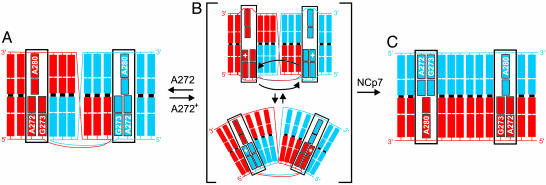Fig. 5.
Model for the pH-dependent structural interconversion of the DIS dimer. DIS stem–loops are shown in blue and red to the second base in the stem. Junction bases are labeled and boxed. (A) The A272 nonprotonated state of the DIS kissing dimer observed at high pH. (B) A two-state representation of the dynamic ensemble of states that results on protonation of A272. Black arrows indicate possible 5′ base motions of A272 and G273 that could result in the observed exchange broadening of the NMR resonances belonging to these and flanking residues. Note that the ensemble may also be comprised of states in which only one of the 5′ bases flips between stacked positions or states in which the purine base motions are more localized. (C) The mature duplex dimer state, showing a model of the NMR-determined structure (39, 40) with all junction bases stacked in toward the helix.

